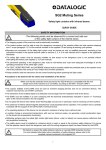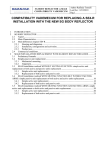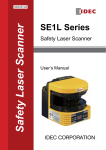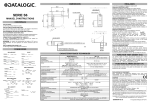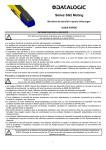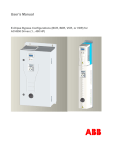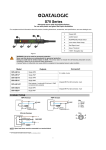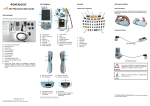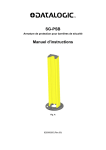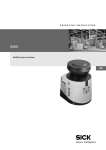Download SG4E_safetylightcurtains_quickguide_RevC_eng (, 174078 byte)
Transcript
SG4-Extended SERIES Safety light curtains with infrared beams QUICK GUIDE SAFETY INFORMATION The following points must be observed for a correct and safe use of the safety light curtains of the SG4-Extended series. The stopping system of the machine must be electrically controlled. This control system must be able to stop the dangerous movement of the machine within the total machine stopping time T as per paragraph 1.3.3 of the manual included in the supplied CD and during all working cycle phases. Mounting and connection of the safety light curtain must be carried out only by qualified personnel, according to the indications included in the special sections (refer to sections 2; 3; 4; 5 of user manual) and in respect to the applicable Standards. The safety light curtain must be securely installed so that access to the dangerous zone is not possible without interrupting the beams (see chapters 2, 3 of user manual). The personnel operating in the dangerous area must be well-trained and must have adequate knowledge of all the operating procedures of the safety light curtain. The TEST, RESET/RESTART and OVERRIDE buttons must be located outside the protected area as the operator must check the protected area during all Test, Restart and Override operations. Please carefully read the instructions for the correct functioning before powering the light curtain. Precautions to be observed for the choice and installation of the device Make sure that the protection level assured by the SG4-E device is compatible with the real danger level of the machine to be controlled, according to EN 954-1 and EN 13849-1. The outputs (OSSD) of the ESPE must be used as machine stopping devices and not as command devices. The machine must have its own START command. The dimension of the smallest object to be detected must be larger than the resolution level of the device. The ESPE must be installed in a room complying with the technical characteristics indicated in section 11 “Technical data” of the manual included in the CD supplied. Do not place the device near intense and/or flashing light sources and, in particular, close to receiving unit front surface. The presence of intense electromagnetic disturbances could jeopardize device operation. This condition has to carefully evaluated with the support of the DATALOGIC Technical service. The operating distance of the device can be reduced in presence of smog, fog or airborne dust. A sudden change in environment temperature, with very low minimum peaks, can generate a small condensation layer on the lenses and so jeopardize functioning. Reflecting surfaces near the safety light curtain light beam (above, under or lateral) can cause passive reflections that can jeopardize functioning. The safety device must be installed at a distance which is major or equal to the minimum safety distance S to ensure that the operator cannot reach the dangerous area until the moving dangerous object has been blocked by the ESPE. The failure to respect the safety distance reduces or cancels ESPE protection function. For more detailed information about calculation of safety distance, please refer to the complete manual contained in the supplied CD. 1 CONNECTIONS SG4-E RX (Muting Operation) M12 12 pole: 1. 24V (brown) 2. 0V (blue) 3. RESET/RESTART/ALIGN (white) 4. OVERRIDE1 (green) 5. OSSD2 (pink) 6. EDM (yellow) 7. MUTING ENABLE (black) 8. OSSD1 (grey) 9. OVERRIDE2 (red) 10. MUTING LAMP (violet) 11. OVERRIDE STATUS (grey-pink) 12. EARTH (red-blue) M12 5 pole: 1. 24V (brown) 2. MUTING2 (white) 3. 0V (blue) 4. MUTING1 (black) 5. N.C. (grey) SG4-E TX M12 5 pole: 1. 24V (brown) 2. TEST (white) 3. 0V (blue) 4. EARTH (black) 5. N.C. SG4-E RX (Blanking Operation) M12 12 pole: 1. 24V (brown) 2. 0V (blue) 3. RESET/RESTART/ALIGN (white) 4. TEACH IN (green) 5. OSSD2 (pink) 6. EDM (yellow) 7. N.C. (black) 8. OSSD1 (grey) 9. TOLERANCE (red) 10. LAMP (violet) 11. N.C. (grey-pink) 12. EARTH (red-blue) 2 ALIGNMENT PROCEDURE The alignment between the emitting and the receiving units is necessary to obtain the correct functioning of the light curtain. A good alignment prevents output instability caused by dust or vibrations. After correct mechanical mounting and electrical wiring user should proceed to alignment procedure and verify results according to next table. To enter SG4-E dedicated Alignment Mode activate RESET/RESTART/ALIGN input during Power-On untill OSSD red led blinks. The alignment is perfect if the optical axes of the first and the last emitting unit beams coincide with the optical axes of the corresponding elements of the receiving unit. Both first (near the connector) and last beam are used for optical SYNC. Alignment status OSSD Status in Normal operation No Sync, check SYNC1 NONE OFF SYNC 1 aligned NONE OFF SYNC 2 aligned NONE OFF One ore more intermediate beam not aligned NONE OFF All beams aligned BAD ON Indication Rx Led configuration All beams aligned ON All beams aligned ON All beams aligned EXCELLENT ON A Keep the receiver in a steady position and set the emitter until the yellow SYNC 1 LED This condition shows the effective alignment of the first synchronisation beam. is OFF. B Rotate the emitter, pivoting on the lower optics axis, until the yellow SYNC 2 LED is OFF. C Delimit the area in which alignment is good and steady through some micro adjustments - for the first and then for the second unit - so to have the maximum alignment LEVEL () and then place both units in the centre of this area. D Fix the two units firmly using brackets. Verify that the LEVEL on the RX unit is as high as possible and beams are not interrupted, then verify that all LEVEL Led turns OFF if even one single beam is interrupted. This verification shall be made with the special cylindrical “Test Piece” having a size suitable to the resolution of the device used (refer to paragraph 2.2.5 “Checks after first installation” of user manual). E Switch OFF and ON the device in standard operating mode. The alignment level is monitored also during device normal operation with the same display (see paragraph 8.1 of user manual). Once the light curtain has been aligned and correctly fastened, the display signal is useful both to check the alignment and show a change in the environmental conditions (occurrence of dust, light disturbance and so on) via signal level monitoring. 3 BASIC CONFIGURATION MODE The device can enter Basic Configuration during Normal Operation. As soon as CONFIRM action after configuration is executed the device automatically restarts in Normal Operation with the new configuration. Particular attention has to be taken during the basic configuration management and use. Muting time-out “” does not comply with the requirements of IEC 61496-1. Therefore all possible risks must be considered and related precautions undertaken before selecting the “”option. A B C E Keep CONFIRM button pressed to enter Basic Configuration Mode. A Test Pattern is shown on led interface, carefully check that ALL led are lit in sequence from 1 to 8, then current configuration is shown. Choose function to set by SELECT button, selected led blinks. Configure selected function with ENABLE button (switch led on/off). Repeat B-C steps until desired configuration is visualized. Keep CONFIRM button pressed to authorize the new configuration Coding RX Function list in Muting (default) operation Mode (Led3 ON Yellow) Setting Function Led # (default in bold) 2 Code 1 Code 2 No Code Muting/Blanking Selection 3 Muting Blanking EDM 4 Enabled Disabled Restart mode 5 Auto Manual Muting Direction 6 T (bidirectional) L (monodirectional) Muting Timeout 7 Override Trigger 8 10 min Inf. Level Edge 4 Led Status Function list in Blanking operation Mode (Led3 OFF) Setting Led # (default in bold) 2 Code 1 Function Coding Led Status Code 2 No Code Muting/Blanking Selection 3 Muting Blanking EDM 4 Enabled Disabled Restart mode 5 Auto Manual Floating Blanking Selection 6-7 Floating Blanking Disabled Floating Blanking 1 beam Floating Blanking 2 beams Reduced Res 4 beams Fixed blanking selection 8 1 Fixed Blanking Zone 2 Fixed Blanking Zones Tx Function list Function Led # Coding 2 Setting (default in bold) Led Status Code 1 Code 2 No Code Range Selection 3 Long Short DIAGNOSTICS FUNCTION The operator can visualize the operating condition of the light curtains thanks to the 8 led positioned on both the RX and TX unit. SG. The figure below shows all signalling LEDs modes: OFF, ON, BLINKING, INDIFFERENT (Can be both On or Off depending on actual working mode) RX UNIT ESPE Working Mode Indication Suggested Action Free beams OSSDs OFF User can restart device in normal operation activating RESTART line. Intercepted beams OSSDs OFF User must free beams path before activating RESTART line. INTERLOCK NORMAL OPERATION OSSD ON SAFE OSSD OFF CODE1 5 RX UNIT ESPE Working Mode Indication SAFE OSSD OFF CODE 2 SAFE OSSD OFF NO CODE - EDM active - ACM active Suggested Action SAFE ACM configuration pending Configuration from PC in progress, follow software instruction. FAILURE LOCKOUT Failure on OSSD(s) Activate RESET line. If error persists contact Datalogic Technical Support. FAILURE LOCKOUT Failure on microprocessor(s) Activate RESET line. If error persists contact Datalogic Technical Support. FAILURE LOCKOUT Failure on optics Activate RESET line. If error persists contact Datalogic Technical Support. FAILURE LOCKOUT failure on EDM Check EDM feedback line and EDM configuration. Activate RESET line. FAILURE LOCKOUT Failure on restart Check RESTART line connection. Activate RESET line. FAILURE LOCKOUT Comunication failure FAILURE LOCKOUT BCM Configuration failure FAILURE LOCKOUT ACM Configuration failure CRITICAL FAILURE LOCKOUT Generic Non-resettable failure ESPE OFF Power supply failure Check cascade connection and correct mounting of terminator cap. Activate RESET line. Re-operate Basic Configuration. If error persists contact Datalogic Technical Support. Re-operate Advanced Configuration. If error persists contact Technical Support Make sure the most recent version of the GUI available on www.datalogic.com is installed. Turn ON/OFF ESPE. Shown Failure Code corresponds to failures above with steady leds. Check Power Supply Connection. If error persists contact Technical Support. RX UNIT (BLANKING ONLY) SAFE NORMAL OP. NORMAL OP SAFE Invalid Blanking (OSSDs OFF) Blanking Zones not respected. Reconfigure Blanking (Teach In if BCM) Valid Blanking (OSSDs ON) Check effective ESPE resolution and intentional activation of tolerance function. BCM Tolerance Active 6 RX UNIT ESPE Working Mode Indication Suggested Action RX UNIT (MUTING ONLY) NORMAL OP SAFE Muting Active NORMAL OP Override Active SAFE If unexpected OSSDs OFF with muting active check Partial Muting Configuration. OSSDs ON, muting lamp flashing. Override attention status Trigger override button to force OSSDs ON. Override timings failure Check and repeat override activation sequence. Check override connections. SAFE Lamp Failure TX UNIT ESPE Working Mode EMISSION TEST Indication Action Emission If undesired Test check TEST line connection. Test EMISSION, TEST Short Range Emission EMISSION, TEST Long Range Emission EMISSION, TEST No code EMISSION, TEST Code 1 EMISSION, TEST Code 2 FAILURE LOCKOUT Failure on microprocessor(s) Activate RESET line. If error persists contact Datalogic Technical Support. FAILURE LOCKOUT Failure on optics Activate RESET line. If error persists contact Datalogic Technical Support. FAILURE LOCKOUT BCM Configuration failure Re-operate Basic Configuration. If error persists contact Datalogic Technical Support. FAILURE LOCKOUT Comunication failure Check cascade connection and correct mounting of terminator cap. Activate RESET line. CRITICAL FAILURE LOCKOUT Generic Non-resettable failure Turn ON/OFF ESPE. Shown Failure Code corresponds to failures above with steady leds. 7 ORIGINAL INSTRUCTIONS (ref. 2006/42/EC) DECLARATION OF CONFORMITY We DATALOGIC declare under our sole responsibility that these products are conform to the IEC 61496-1 (2004) and IEC 61496-2 (2006) Standards and successive amendments WARRANTY DATALOGIC warrants its products to be free from defects. DATALOGIC will repair or replace, free of charge, any product found to be defective during the warranty period of 36 months from the manufacturing date. This warranty does not cover damage or liability deriving from the improper application of DATALOGIC products. DATALOGIC AUTOMATION srl Via Lavino 265 - 40050 Monte S.Pietro - Bologna – Italy Tel: +39 051 6765611 - Fax: +39 051 6759324 www.datalogic.com DATALOGIC cares for the environment: 100% recycled paper. DATALOGIC reserves the right to make modifications and improvements without prior notification. © 2011 – 2013 Datalogic Automation - ALL RIGHTS RESERVED - Protected to the fullest extent under U.S. and international laws. • Copying, or altering of this document is prohibited without express written consent from Datalogic Automation. Datalogic and the Datalogic logo are registered trademarks of Datalogic S.p.A. in many countries, including the U.S.A. and the E.U. 826007123 Rev.C 8








